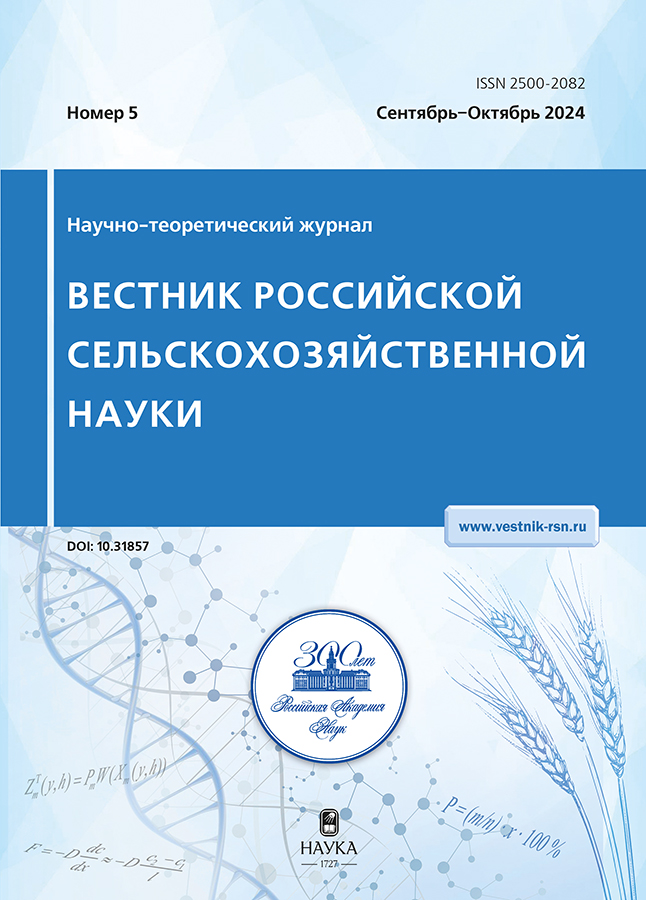Pathomorphological changes and immunolocalization of matrix metalloproteinases in the placenta of cows during afterbirth retention
- Autores: Avdeenko V.S.1, Moroz A.I.1, Safronov D.I.1, Finageev E.Y.1, Makavchik S.P.1, Moiseeva K.A.1
-
Afiliações:
- State Educational Institution of Higher Education St. Petersburg State University of Veterinary Medicine
- Edição: Nº 5 (2024)
- Páginas: 94-101
- Seção: Zootechnics
- URL: https://vietnamjournal.ru/2500-2082/article/view/659256
- DOI: https://doi.org/10.31857/S2500208224050195
- EDN: https://elibrary.ru/zruozs
- ID: 659256
Citar
Texto integral
Resumo
For the first time, using histochemical and immunohistochemical methods, epithelialized defects with signs of dystrophy in the crypts of caruncles in cows with afterbirth retention were established. The number of diplocaryocytes per unit area in the placenta of a cow during normal delivery was three times higher than the number of cells in cows with afterbirth retention. In the stroma of the villi of the allantochorion of the cotyledons, an increase in the number of collagen fibers and an increase in the number of fibroblasts, which are larger than in normal childbirth, have been established. In samples obtained from cows with afterbirth retention in the stroma of defragmented maternal crypts, the distribution of MMP was established, and immunopositive cells were fixed around the vessels, with active production of MMP-1 and MMP-3. Decreases in MMP-2 and MMP-9 in placentomas were observed in the allantochorion villi of the fetal part of the placenta. Thus, MMP-2 and МMP-9 are localized in the cotyledon and can affect the timely release of allantochorion villi from the crypts of the caruncles, ensuring the separation of fetal membranes from the maternal placenta in cattle.
Texto integral
Sobre autores
V. Avdeenko
State Educational Institution of Higher Education St. Petersburg State University of Veterinary Medicine
Autor responsável pela correspondência
Email: sashamoroz.shuramoroz@mail.ru
Grand PhD in Veterinary Sciences
Rússia, St. PetersburgA. Moroz
State Educational Institution of Higher Education St. Petersburg State University of Veterinary Medicine
Email: sashamoroz.shuramoroz@mail.ru
PhD Student
Rússia, St. PetersburgD. Safronov
State Educational Institution of Higher Education St. Petersburg State University of Veterinary Medicine
Email: sashamoroz.shuramoroz@mail.ru
PhD in Veterinary Sciences
Rússia, St. PetersburgE. Finageev
State Educational Institution of Higher Education St. Petersburg State University of Veterinary Medicine
Email: sashamoroz.shuramoroz@mail.ru
PhD in Veterinary Science
Rússia, St. PetersburgS. Makavchik
State Educational Institution of Higher Education St. Petersburg State University of Veterinary Medicine
Email: sashamoroz.shuramoroz@mail.ru
Grand PhD in Veterinary Sciences
Rússia, St. PetersburgK. Moiseeva
State Educational Institution of Higher Education St. Petersburg State University of Veterinary Medicine
Email: sashamoroz.shuramoroz@mail.ru
PhD Student
Rússia, St. PetersburgBibliografia
- Evglevskij A.A. Aspekty razvitiya metabolicheskogo acidoza i ketoacidoza u korov v promyshlennom zhivotnovodstve // Vestnik rossijskoj sel’skohozyajstvennoj nauki. 2022. № 3. S. 71–75. https://doi.org/10.30850/vrsn/2022/3/71-75
- Klyuchnikova N.F., Klyuchnikov M.T., Klyuchnikova E.M. Effektivnost’ primeneniya akantopanaksa dlya profilaktiki yalovosti korov // Vestnik rossijskoj sel’skohozyajstvennoj nauki. 2023. № 6. S. 91–94. https://doi.org/10.31857/2500-2082/2023/6/91-94
- Rodin I.A., Sedov A.V., Kapustin A.V. i dr. Rasprostranennost’ i etiologicheskie faktory, obuslavlivayushchie zaderzhanie plodnyh obolochek u korov // Siberian Journal of Life Sciences and Sciences and Agriculture. 2021. T. 13. № 4. S. 144–158.
- Breda F.L., Manchado-Gobatto F.B., de Barros Sousa F.A. et al. Complex networks analysis reinforces centrality hematological role on aerobic–anaerobic performances of the Brazilian Paralympic endurance team after altitude training // Scientific Reports. 2022. Vol. 7. No. 12. PP. 114–120.
- Davenport K.M., Ortega M.S., Johnson G.A., Seo H. Implantation and placentation in ruminants // Animal. 2023. Vol. 17. No. 5. PP. 180–196. https://doi.org/10.1016/j.animal.2023.100796.
- Davenport K.M., O’Neil E.V., Ortega M.S. et al. Single-cell insights into development of the bovine placenta // 2024. Vol. 110. No. 1. PP. 169–184. https://doi.org/10.1093/biolre/ioad123
- Hooshmandabbasi R., Zerbe H., Bauersachs S. et al. Pregnancy-associated glycoproteins in cows with retained fetal membranes // Theriogenology. 2018. Vol. 105. PP. 158–163.
- Johnson Gregory A., Bazer Fuller W., Heewon Seo et al. Understanding placentation in ruminants: a review focusing on cows and sheep Reprod Fertil Dev. 2023. Vol. 36. No. 2. PP. 93–111. https://doi.org/10.1071/RD23119
- Kamada H., Matsui Y. Twelve-oxoeicosatetraenoic acid-induced fetal membrane release improves postpartum ovarian function, milk production, and blood plasma biochemical parameters in cows // Animal bioscience. 2023. Vol. 36. No 9. PP. 137–146. https://doi.org/10.5713/ab.22.0443
- Lean I.J., LeBlanc S.J., Sheedy D.B. et al. Associations of parity with health disorders and blood metabolite concentrations in Holstein cows in different production systems // J Dairy Sci. 2023. Vol. 106. No. 1. PP. 500–518. https://doi.org/10.3168/jds.2021-21673
- Sarli G., Castagnetti C., Bianco C. et al. Canine placenta histological findings and microvascular density: the histological basis of a negative neonatal outcome? // Animals. 2021. Vol. 11. No. 5. PP. 1418–1400. https://doi.org/10.3390/ani11051418
- Scariot C.A., Scariot J., de Souza Ramos I.A. et al. Bovine anaplasmosis as a risk factor for retained placenta, mastitis, and abomasal displacement in dairy cattle // Res Vet Sci. 2023. Vol. 154. PP. 145–150. https://doi.org/10.1016/j.rvsc.2022.12.011
- Scariot P.P., Gobatto C.A., Polisel E.E. et al. Early-life mice housed in standard stocking density reduce the spontaneous physical activity and increase visceral fat deposition before reaching adulthood // Laboratory Animals. 2022. Vol. 4. No. 4. PP. 234–247.
- Scariot P.P., Manchado-Gobatto F.B., Beck W.R. et al. Monocarboxylate transporters (MCTs) in skeletal muscle and hypothalamus of less or more physically active mice exposed to aerobic training Life Sciences. 2022. Vol. 1. No. 307. PP. 120–128.
- Pereira K.H.N.P., Lourenço M.L. Reanimação neonatal de cães e gatos ao nascimento // Rev Bras Reprod Anim. 2022. Vol. 46. P. 3–16. https://doi.org/10.3390/ani12233426
- Tanner A.R., Kennedy V.C., Lynch C.S. et al. In vivo investigation of ruminant placenta function and physiology // Journal of animal science. 2022. Vol. 100. No. 6. PP. 1023–1043. https://doi.org/10.1093/jas/skac045
Arquivos suplementares















